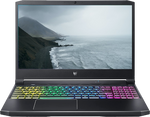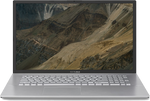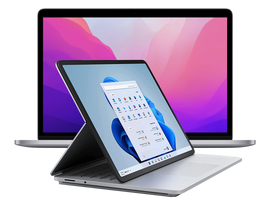A comparison of specs, key information, reviews, and best pricing from top retailers
Last updated -- hours ago | Report incorrect information
What we think

The PerfectRec laptop team Learn more
Updated January 10, 2024·
If you require a laptop for heavy tasks like gaming or engineering software, the Acer Predator Helios 300 offers a more powerful processor and graphics card, which translates to better performance for these intensive applications; however, this comes at the cost of higher price, less portability due to its heavier weight, and shorter battery life. On the other hand, the ASUS Vivobook 17 is more affordable and offers better battery life, making it suitable for general use and more portable, but its lower-powered processor and integrated graphics would struggle with demanding software and games. Give Feedback
this description is based on the product variant with some specs and product variant with some specs. At the time of writing, the variant with some specs cost some dollars and the variant with some specs cost some dollars.
Advantages of the Acer Predator Helios 300
- Good for engineering and design
- Good for gaming and AI
- Good for software development
- Good overall display quality
- Good overall build quality
- Good speakers
- Good keyboard
Advantages of the ASUS Vivobook 17
- Good portability
- Good battery life
Key differences
Gaming and AI
7.2


6.0
6.8/10
OVERALL GPU SCORE
3.6/10
1920 x 1080
RESOLUTION
1920 x 1080
144Hz
REFRESH RATE
60Hz
Yes
SUPPORTS DLSS
No
No
MUX SWITCH / ADVANCED OPTIMUS
No
7.5/10
FAN NOISE SCORE
9.5/10
The Acer Predator Helios 300 is good for gaming and AI, while the ASUS Vivobook 17 is only fair.
PerfectRec’s Gaming and AI Score strongly emphasizes graphics processing capability, while also taking into account other factors that impact suitability for gaming and AI work.
Engineering and Design
7.6


6.3
7.4/10
OVERALL CPU SCORE
6.2/10
6.8/10
OVERALL GPU SCORE
3.6/10
16.0 GB
RAM
8.0 GB
The Acer Predator Helios 300 is good for engineering and design, while the ASUS Vivobook 17 is only fair.
The Acer Predator Helios 300 outperforms the ASUS Vivobook 17 in engineering and design applications due to its superior main processor, double the RAM, and a more powerful GPU, which are critical for demanding software used in those fields. Moreover, the Helios 300's screen quality is better, with a higher brightness, refresh rate, and color space coverage, which provides a more accurate visual experience, albeit it is less portable and may have louder operating noise compared to the lighter and quieter Vivobook 17.
Screen Quality
7.3


6.2
15.6in
SIZE
17.3in
1920 x 1080
RESOLUTION
1920 x 1080
IPS
DISPLAY TECHNOLOGY
IPS
144Hz
REFRESH RATE
60Hz
294.0 nits
BRIGHTNESS
263.0 nits
The Acer Predator Helios 300 has a better screen than the ASUS Vivobook 17 for general use, gaming and AI, engineering and design, software development, and content creation.
The Acer Predator Helios 300 has a screen that offers vibrant colors and high resolution, making it suitable for general use and engineering tasks which require accurate color representation, but its lower refresh rate can be a drawback for gaming where smoother motion is crucial. The ASUS Vivobook 17, with its fair resolution and color accuracy, can handle everyday tasks and some engineering applications, but might not be as pleasing for color-critical work. Both laptops' displays are not optimized for gaming or 3D modeling, with their lower refresh rates causing potential motion blur and less fluid visuals, important aspects where gamers and 3D designers require fast and seamless image updates.
Battery
3.5 Hours


6.0 Hours
The Acer Predator Helios 300 has 3.5 hours of battery life. The ASUS Vivobook 17 has 6 hours of battery life.
Battery life estimate is based on a mix of common use patterns. More portable and higher performing laptops tend to have less battery life.
Build Quality
7.4


6.5
The Acer Predator Helios 300 has good build quality, while the ASUS Vivobook 17 has only fair build quality.
PerfectRec’s Build Quality Score incorporates case materials, display and keyboard flex, hinge quality, and overall reliability.
Cost
$1,099


$430
$0
$500
$1,000
$1,500
$2,000
The Acer Predator Helios 300 has a price of $1,099 and the ASUS Vivobook 17 costs $430.

Let Us Help Find Your Perfect Laptop
Find your new laptop
Key similarities
General Use
7.4


7.0
1920 x 1080
RESOLUTION
1920 x 1080
IPS
DISPLAY TECHNOLOGY
IPS
294.0 nits
DISPLAY BRIGHTNESS
263.0 nits
3.5 Hours
BATTERY LIFE
6.0 Hours
7.5/10
KEYBOARD QUALITY SCORE
6.0/10
6.9/10
PORTABILITY SCORE
7.2/10
The Acer Predator Helios 300 and ASUS Vivobook 17 are both good for general use.
The Acer Predator Helios 300 is more suitable for general use due to its higher-performance CPU and double the RAM of the ASUS Vivobook 17, which boosts multitasking and speed. Additionally, the Predator has a higher quality and brighter screen, enhancing the viewing experience, but it is heavier and has a shorter battery life than the lighter Vivobook, which may be a better fit for those prioritizing portability and longer use away from a power source.
Content Creation
7.3


7.0
7.4/10
OVERALL CPU SCORE
6.2/10
1920 x 1080
RESOLUTION
1920 x 1080
16.0 GB
RAM
8.0 GB
IPS
DISPLAY TECHNOLOGY
IPS
The Acer Predator Helios 300 and ASUS Vivobook 17 are both good for content creation.
PerfectRec’s Content Creation Score takes into account the many different features of the laptop that make it more or less suitable for photo editing, video editing and other content creation tasks.
Software Development
7.1


6.9
7.4/10
OVERALL CPU SCORE
6.2/10
16.0 GB
RAM
8.0 GB
1920 x 1080
RESOLUTION
1920 x 1080
7.5/10
KEYBOARD QUALITY SCORE
6.0/10
Although they have very similar scores, PerfectRec considers Acer Predator Helios 300 to be good for software development, while the ASUS Vivobook 17 is only fair.
PerfectRec’s Software Development Score takes into account the many different features of the laptop that make it more or less suitable for software developers.
Portability
Fair


Good
15.6in
SIZE
17.3in
5.5 lbs
WEIGHT
4.6 lbs
0.9in
THICKNESS
0.7in
Although they have very similar scores, PerfectRec considers ASUS Vivobook 17 to have good portability, while the Acer Predator Helios 300 has only fair portability.
The most portable laptops are small, thin, and light.
Give feedback
We’re constantly working to improve.
How the Acer Predator Helios 300 and the ASUS Vivobook 17 compare to other laptops
Spec Comparison
| Acer Predator Helios 300 | ASUS Vivobook 17 |
GENERAL | |||
|---|---|---|---|
| Price | |||
$1,099 | $430 | ||
Release Date | |||
Release Date | May 1, 2021 | May 1, 2022 | |
Overall Dimensions | |||
Overall Dimensions | 14.3'' x 10'' x 0.9'' | 15.7'' x 9.9'' x 0.78'' | |
Weight | |||
Weight | 5.51 lbs | 4.63 lbs | |
Width | |||
Width | 14.3" | 15.72" | |
Depth | |||
Depth | 10" | 9.89" | |
INTERNAL | |||
|---|---|---|---|
Processor | |||
Processor | Intel i7-11800H | Intel i3-1220P | |
RAM | |||
RAM | 16 GB | 8 GB | |
DDR Memory Version | |||
DDR Memory Version | 4 | 4 | |
RAM Slots | |||
RAM Slots | 2 | 1 | |
Storage | |||
Storage | 512 GB | 256 GB | |
BATTERY | |||
|---|---|---|---|
Battery Life | |||
Battery Life | 3.5 Hours | 6 Hours | |
Battery Capacity | |||
Battery Capacity | 59 Wh | 50 Wh | |
SCREEN | |||
|---|---|---|---|
Diagonal Size | |||
Diagonal Size | 15.6" | 17.3" | |
Display Technology | |||
Display Technology | IPS | IPS | |
Resolution | |||
Resolution | 1920 x 1080 | 1920 x 1080 | |
Refresh Rate | |||
Refresh Rate | 144Hz | 60Hz | |
Display Brightness | |||
Display Brightness | 294 nits | 263 nits | |
RELIABILITY, APPEARANCE & ACOUSTICS | |||
|---|---|---|---|
Build Quality Score | |||
Build Quality Score | 7.4/10 | 6.5/10 | |
Portability Score | |||
Portability Score | 6.9/10 | 7.2/10 | |
Gaming Laptop Appearance | |||
Gaming Laptop Appearance | Yes | No | |
Premium Business Laptop | |||
Premium Business Laptop | No | No | |
Fan Noise Score | |||
Fan Noise Score | 7.5/10 | 9.5/10 | |
HARDWARE FEATURES | |||
|---|---|---|---|
Keyboard Quality Score | |||
Keyboard Quality Score | 7.5/10 | 6/10 | |
Speaker Quality Score | |||
Speaker Quality Score | 7/10 | 6.5/10 | |
Webcam | |||
Webcam | 720p | 720p | |
Fingerprint Reader | |||
Fingerprint Reader | No | No | |
Backlit Keyboard | |||
Backlit Keyboard | Yes | No | |
Number Pad | |||
Number Pad | Yes | Yes | |
CONNECTIVITY | |||
|---|---|---|---|
USB Type-A | |||
USB Type-A | 3 | 3 | |
USB-C ports | |||
USB-C ports | 1 | 1 | |
USB-C Charging | |||
USB-C Charging | No | No | |
Display Outputs | |||
Display Outputs | 3 | 1 | |
Thunderbolt Version | |||
Thunderbolt Version | 4 | N/A | |
Shopping
Acer Predator Helios 300
See more
Dig into reviews and images
NotebookCheck
Christian Hintze | November 2022
"The Acer Predator Helios 300 review is an overclocked gaming laptop with a good display. The Predator is large, heavy, and loud, but also offers plenty of performance according to gamers. An overclocked gaming laptop - or its user - also has to struggle with the usual disadvantages we mentioned above. On the other hand, overclocking is optional, and those who like it quieter and can live with a few less frames per second can also switch to the significantly more moderate Standard mode. Then the Helios 300 won't be any louder than the competitors."
ASUS Vivobook 17
See more
Dig into reviews and images
NotebookCheck
Marvin Gollor | May 2022
"The ASUS Vivobook 17 is an affordable 17-inch laptop with passive cooling. On one hand, you get a really quiet and cool work device with a good system performance, many connections, good maintenance options, speakers acceptable for multimedia enjoyment, and a sharp and clear matte FHD IPS display with the Asus VivoBook 17 (F712JA). On the other hand, the USB-C port lacks Power Delivery and DisplayPort, and the display, a higher brightness and better color space coverage."
Get a great deal on the Acer Predator Helios 300 or the ASUS Vivobook 17
About Acer
Acer is a prominent Taiwanese electronics brand which makes a wide range of laptops, with multiple product lines catering to personal use, gaming, and business use. They are renowned for having exceptional value for money, as they frequently offer good specifications at a lower price than other manufacturers.
About ASUS
ASUS, a Taiwanese electronics brand, is one of the largest personal computer vendor by market share. The majority of their laptops are targeted towards personal use or gaming. Their most popular product lines include the budget-friendly VivoBook, more premium ZenBook, and their TUF and ROG gaming laptops, the latter of which has a reputation for excellent gaming performance.
Give feedback
We're constantly perfecting our model
Laptop guides you might be interested in
More comparisons for you
Compare Acer Predator Helios 300 vs. Apple MacBook Air (2022)
VS
Compare Acer Predator Helios 300 vs. Apple MacBook Air 15 (2023)
VS
Compare Acer Predator Helios 300 vs. MSI Cyborg 15
VS
Compare ASUS Vivobook 17 vs. HP Envy x360 15"
VS
Compare ASUS Vivobook 17 vs. Acer Aspire 3 14
VS
Compare ASUS Vivobook 17 vs. HP 15" Laptop
VS
FAQs
FAQs about laptops
Why trust us
This information was produced and vetted by the PerfectRec laptops team. We are a product research and recommendation organization that meticulously reviews and evaluates the latest laptop information and makes it digestible for you.
By the numbers
380
Laptops evaluated
48,640
Laptops stats compiled
13
Proprietary Laptops ratings developed
126,195
Recommendations made
27,343
Consumer hours saved
About the laptop team
Joe Golden, Ph.D
CEO and Laptops Editor
Joe is an entrepreneur and lifelong electronics enthusiast with a Ph.D in Economics from the University of Michigan.
Jason Lew
Staff Expert & Software Engineer
Jason is a staff expert and software engineer that has been making laptop recommendations for 7 years and moderates one of the largest laptop subreddits.
Chandradeep Chowdhury
Staff Expert & Software Engineer
Chandradeep is a staff expert and software engineer and expert in televisions and monitors. He’s been making monitor recommendations for ten years.
Craig Russell
Laptops Expert
Craig is a UK-based laptops expert. Craig works in IT, where he recommends and supports laptops and PCs for clients and has been recommending laptops on Reddit for five years.







